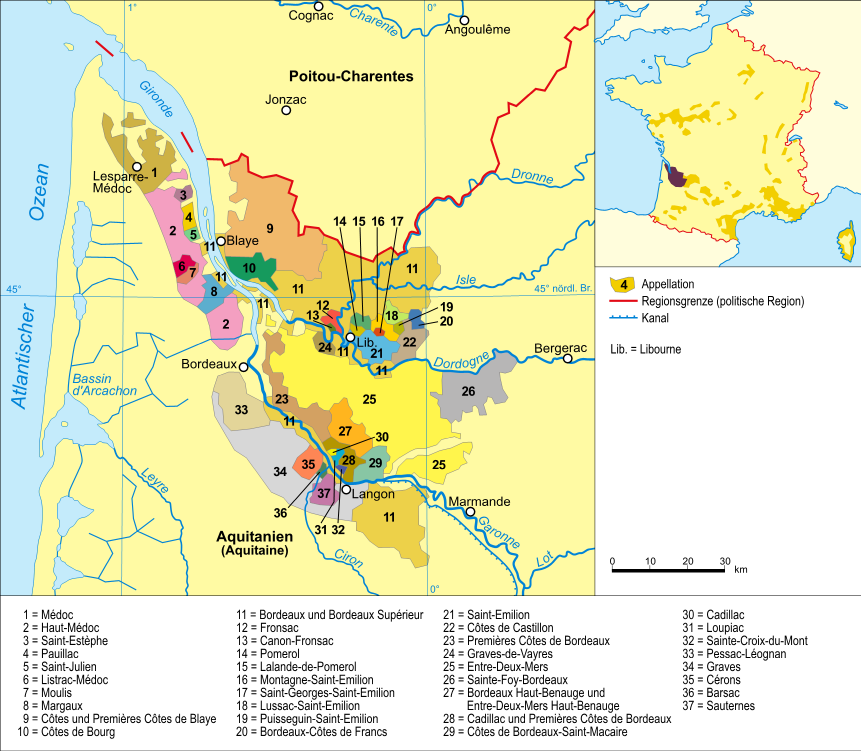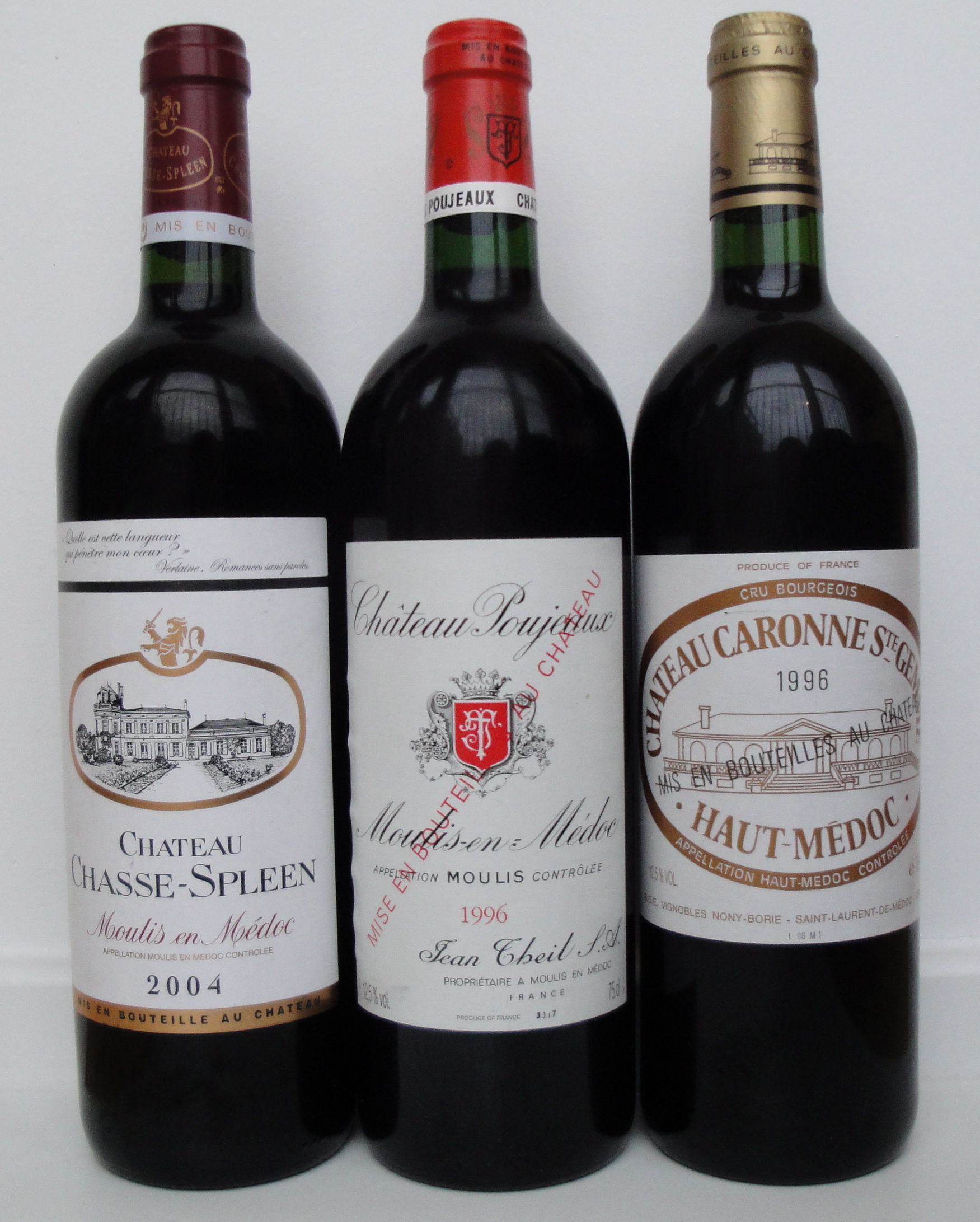|
Médoc
The Médoc (; ) is a region of France, well known as a wine growing region, located in the '' département'' of Gironde, on the left bank of the Gironde estuary, northwest of Bordeaux. Its name comes from ''( Pagus) Medullicus'', or "country of the '' Medulli''", the local Celtic tribe. The region owes its economic success mainly to the production of red wine; it is home to around 1,500 vineyards. The area also has pine forests and long sandy beaches. The Médoc's geography is not ideal for wine grape growing, with its proximity to the Atlantic Ocean resulting in a comparatively mild climate and high rainfall making grape rot a constant problem. It is generally believed that the nature of the region's wine derives from the soil; although the terrain is flat, excellent drainage is present and the increased amount of gravel in the soil allows heat to be retained, encouraging ripening, and extensive root systems. Viticulture With the exception of Château Haut-Brion from Gra ... [...More Info...] [...Related Items...] OR: [Wikipedia] [Google] [Baidu] [Amazon] |
Bordeaux Wine Regions
The wine regions of Bordeaux in France are a large number of wine growing areas, differing widely in size and sometimes overlapping, which lie within the overarching wine region of Bordeaux, centred on the city of Bordeaux and covering the whole area of the Gironde department of Aquitaine. The Bordeaux region is naturally divided by the Gironde Estuary into a Left Bank area which includes the Médoc AOC, Médoc and Graves (wine region), Graves and a Right Bank area which includes the Libournais, Côtes de Bourg, Bourg and Blaye (wine), Blaye. The Médoc is itself divided into Haut-Médoc AOC, Haut-Médoc (the upstream or southern portion) and Bas-Médoc (the downstream or northern portion, often referred to simply as "Médoc"). There are various sub-regions within the Haut-Médoc, including Saint-Estèphe AOC, St-Estèphe, Pauillac AOC, Pauillac, Saint-Julien AOC, St.-Julien and Margaux AOC, Margaux and the less well known areas of AOC Moulis and Listrac. Graves includes the sub- ... [...More Info...] [...Related Items...] OR: [Wikipedia] [Google] [Baidu] [Amazon] |
Cru Bourgeois
The Cru Bourgeois classification lists some of the Château#Bordeaux, châteaux from the Médoc that were not included in the Bordeaux Wine Official Classification of 1855, 1855 Classification of ''Crus Classés'', or Classed Growths. Notionally, ''Cru Bourgeois'' is a level below ''Cru Classé'', but still of high quality (formerly there were additional grades of ''Cru Artisan'' and ''Cru Paysan''). Many wine writers consider that there is some overlap in quality between the Classed Growths and the Cru Bourgeois, although also saying that by and large the Classed Growths still represent the best wines. The first Cru Bourgeois list was drawn up by the Bordeaux Chamber of Commerce and Chamber of Agriculture in 1932, selecting 444 estates for the classification. The words ''Cru Bourgeois'' were widely used on labels by the châteaux so listed, although the classification was never officially ratified. A substantial revision of the classification, dividing it into three tiers, was i ... [...More Info...] [...Related Items...] OR: [Wikipedia] [Google] [Baidu] [Amazon] |
Bordeaux Wine Official Classification Of 1855
The Bordeaux Wine Official Classification of 1855 resulted from the Exposition Universelle (1855), 1855 Exposition Universelle de Paris, when Emperor Napoleon III of France, Napoleon III requested a classification system for France's best Bordeaux wines that were to be on display for visitors from around the world. Brokers from the wine industry ranked the wines according to a château's reputation and trading price, which at that time was directly related to quality. The wines were ranked in importance from first growth, first to fifth growths (''cru (wine), crus''). All of the red wines that made it on the list came from the Médoc region except for one: Château Haut-Brion from Graves (wine region), Graves. The white wines, then of much less importance than red wine, were limited to the sweet varieties of Sauternes (wine), Sauternes and Barsac AOC, Barsac and were ranked only from superior first growth to second growth. Changes to the classification Within each category, th ... [...More Info...] [...Related Items...] OR: [Wikipedia] [Google] [Baidu] [Amazon] |
Graves (wine Region)
Graves (, ''gravelly land'') is an important subregion of the Bordeaux wine region. Graves is situated on the left bank of the Garonne River, in the upstream part of the region, southeast of the city Bordeaux and stretches over . Graves is the only Bordeaux subregion famed for all three of Bordeaux's three main wine types (reds, dry whites and sweet wines) although red wines dominate the total production. Graves AOC is also the name of one ''Appellation d'origine contrôlée'' (AOC) that covers most but not all of the Graves subregion. The area encompasses villages including Sauternes, Pessac, Talence, Léognan, Martillac, Saint-Morillon, and Portets. The name "Graves" derives from its intensely gravelly soil.H. Johnson & J. Robinson ''The World Atlas of Wine'' pg 98 Mitchell Beazley Publishing 2005 The soil is the result of glaciers from the Ice Age, which also left white quartz deposits that can still be found in the soil of some of the top winemaking estates.K. MacNeil ' ... [...More Info...] [...Related Items...] OR: [Wikipedia] [Google] [Baidu] [Amazon] |
Château Haut-Brion
Château Haut-Brion () is a French wine estate of Bordeaux wine, rated a ''Premier Grand Cru Classé'' ( First Growth), located in Pessac just outside the city of Bordeaux. It differs from the other wines on the list in its geographic location in the north of the wine-growing region of Graves. Of the five first growths, it is the only wine with the Pessac-Léognan appellation and is in some sense the ancestor of a classification that remains the benchmark to this day. In addition to the ''grand vin'' ( LWIN 1011247), Haut-Brion produces a red second wine. Formerly named Château Bahans Haut-Brion, beginning with the 2007 vintage, it was renamed Le Clarence de Haut Brion ( LWIN 1008153). The vineyard also produces a dry white wine named Château Haut-Brion Blanc ( LWIN 1017092), with a limited release of the second dry white wine, Les Plantiers du Haut-Brion, renamed La Clarté de Haut-Brion for the 2008 vintage. History Although grapes are thought to have been grown on th ... [...More Info...] [...Related Items...] OR: [Wikipedia] [Google] [Baidu] [Amazon] |
Gironde Estuary
The Gironde estuary ( , US usually ; , ; , ) is a navigable estuary (though often referred to as a river) in southwest France and is formed from the meeting of the rivers Dordogne and Garonne just downstream of the centre of Bordeaux. Covering around , it is the largest estuary in western Europe. Giving its name to the French '' département'' Gironde, the Gironde estuary is approximately long and 3–12 km (2–7 miles) wide. It is subject to very strong tidal currents and great care is needed when navigating the estuary by any size or type of boat. Since 2015, the Gironde estuary has been part of the Gironde estuary and Pertuis sea Marine Nature Park. Islands of the Gironde Within the estuary between the Pointe de Grave at the seaward end and the Bec d'Ambès are a series of small islands. The Île de Patiras is in size with a lighthouse to aid navigation in the estuary. Vines and maize are grown there. The Île Sans-Pain and Île Bouchaud are now ... [...More Info...] [...Related Items...] OR: [Wikipedia] [Google] [Baidu] [Amazon] |
Bordeaux
Bordeaux ( ; ; Gascon language, Gascon ; ) is a city on the river Garonne in the Gironde Departments of France, department, southwestern France. A port city, it is the capital of the Nouvelle-Aquitaine region, as well as the Prefectures in France, prefecture of the Gironde department. Its inhabitants are called "''Bordelais'' (masculine) or "''Bordelaises'' (feminine). The term "Bordelais" may also refer to the city and its surrounding region. The city of Bordeaux proper had a population of 259,809 in 2020 within its small municipal territory of , but together with its suburbs and exurbs the Bordeaux Functional area (France), metropolitan area had a population of 1,376,375 that same year (Jan. 2020 census), the sixth-most populated in France after Paris, Lyon, Marseille, Lille, and Toulouse. Bordeaux and 27 suburban municipalities form the Bordeaux Métropole, Bordeaux Metropolis, an Indirect election, indirectly elected Métropole, metropolitan authority now in charge of wi ... [...More Info...] [...Related Items...] OR: [Wikipedia] [Google] [Baidu] [Amazon] |
Gironde
Gironde ( , US usually , ; , ) is the largest department in the southwestern French region of Nouvelle-Aquitaine. Named after the Gironde estuary, a major waterway, its prefecture is Bordeaux. In 2019, it had a population of 1,623,749.Populations légales 2019: 33 Gironde INSEE The famous Bordeaux wine region is in Gironde. It has six arrondissements, making it one of the departments with the most arrondissements ( [...More Info...] [...Related Items...] OR: [Wikipedia] [Google] [Baidu] [Amazon] |
France
France, officially the French Republic, is a country located primarily in Western Europe. Overseas France, Its overseas regions and territories include French Guiana in South America, Saint Pierre and Miquelon in the Atlantic Ocean#North Atlantic, North Atlantic, the French West Indies, and List of islands of France, many islands in Oceania and the Indian Ocean, giving it Exclusive economic zone of France, one of the largest discontiguous exclusive economic zones in the world. Metropolitan France shares borders with Belgium and Luxembourg to the north; Germany to the northeast; Switzerland to the east; Italy and Monaco to the southeast; Andorra and Spain to the south; and a maritime border with the United Kingdom to the northwest. Its metropolitan area extends from the Rhine to the Atlantic Ocean and from the Mediterranean Sea to the English Channel and the North Sea. Its Regions of France, eighteen integral regions—five of which are overseas—span a combined area of and hav ... [...More Info...] [...Related Items...] OR: [Wikipedia] [Google] [Baidu] [Amazon] |
Celt
The Celts ( , see Names of the Celts#Pronunciation, pronunciation for different usages) or Celtic peoples ( ) were a collection of Indo-European languages, Indo-European peoples. "The Celts, an ancient Indo-European people, reached the apogee of their influence and territorial expansion during the 4th century BC, extending across the length of Europe from Britain to Asia Minor."; . "[T]he Celts, were Indo-Europeans, a fact that explains a certain compatibility between Celtic, Roman, and Germanic mythology."; . "The Celts and Germans were two Indo-European groups whose civilizations had some common characteristics."; . "Celts and Germans were of course derived from the same Indo-European stock."; . "Celt, also spelled Kelt, Latin Celta, plural Celtae, a member of an early Indo-European people who from the 2nd millennium bce to the 1st century bce spread over much of Europe." in Europe and Anatolia, identified by their use of Celtic languages and other cultural similarities.. "C ... [...More Info...] [...Related Items...] OR: [Wikipedia] [Google] [Baidu] [Amazon] |
Atlantic Ocean
The Atlantic Ocean is the second largest of the world's five borders of the oceans, oceanic divisions, with an area of about . It covers approximately 17% of Earth#Surface, Earth's surface and about 24% of its water surface area. During the Age of Discovery, it was known for separating the New World of the Americas (North America and South America) from the Old World of Afro-Eurasia (Africa, Asia, and Europe). Through its separation of Afro-Eurasia from the Americas, the Atlantic Ocean has played a central role in the development of human society, globalization, and the histories of many nations. While the Norse colonization of North America, Norse were the first known humans to cross the Atlantic, it was the expedition of Christopher Columbus in 1492 that proved to be the most consequential. Columbus's expedition ushered in an Age of Discovery, age of exploration and colonization of the Americas by European powers, most notably Portuguese Empire, Portugal, Spanish Empire, Sp ... [...More Info...] [...Related Items...] OR: [Wikipedia] [Google] [Baidu] [Amazon] |







